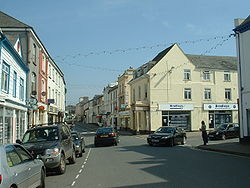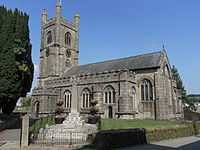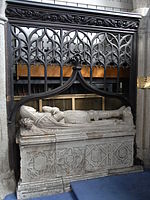Callington: Difference between revisions
Created page with '{{Infobox town |name=Callington |cornish=Kelliwik |county=Cornwall |picture=Callington 1.jpg |picture caption=Fore Street, Callington |os grid ref=SX359696 |latitude=50.503 |long…' |
m →Railway: clean up, replaced: train station → railway station |
||
| Line 46: | Line 46: | ||
===Railway=== | ===Railway=== | ||
Callington railway station was the terminus of a branch line from [[Bere Alston]], the junction with the Southern Railway's Tavistock to Plymouth line. The railway line beyond [[Gunnislake]] to the Callington terminus was closed in the 1960s, due to low usage and difficult operating conditions on the final sections of the line due to several severe gradients and speed restrictions. One can still travel by rail on the Tamar Valley Line from Plymouth as far as Gunnislake via Bere Alston, where trains reverse. For most of its journey the line follows the River Tamar. The nearest mainline | Callington railway station was the terminus of a branch line from [[Bere Alston]], the junction with the Southern Railway's Tavistock to Plymouth line. The railway line beyond [[Gunnislake]] to the Callington terminus was closed in the 1960s, due to low usage and difficult operating conditions on the final sections of the line due to several severe gradients and speed restrictions. One can still travel by rail on the Tamar Valley Line from Plymouth as far as Gunnislake via Bere Alston, where trains reverse. For most of its journey the line follows the River Tamar. The nearest mainline railway station to Callington is at Saltash. | ||
==Economy== | ==Economy== | ||
Latest revision as of 20:38, 29 January 2021
| Callington Cornish: Kelliwik | |
| Cornwall | |
|---|---|
 Fore Street, Callington | |
| Location | |
| Grid reference: | SX359696 |
| Location: | 50°30’11"N, 4°18’58"W |
| Data | |
| Population: | 4,783 (2001) |
| Post town: | Callington |
| Postcode: | PL17 |
| Dialling code: | 01579 |
| Local Government | |
| Council: | Cornwall |
| Parliamentary constituency: |
South East Cornwall |
Callington is village in southeastern Cornwall, found about 7 miles north of Saltash and 9 miles south of Launceston. The parish had a population of 4,783 at the 2001 census.
The town is poised between Bodmin Moor to the west and Dartmoor over in Devon to the east. A former agricultural market town, it lies at the intersection of the south-north A388 Saltash to Launceston road and the east-west A390 Tavistock to Liskeard road.
Kit Hill is a mile northeast of the town and rises to 1,093 feet with views of Dartmoor, Bodmin Moor and the River Tamar.
The hamlets of Bowling Green, Frogwell, Kelly Bray and Newbridge are in the parish.
Parish church

The parish church is St Mary’s.
St Mary's Church was originally a chapel of ease to South Hill. It was consecrated in 1438 and then had two aisles and a buttressed tower; a second north aisle was added in 1882. Unusually for Cornwall there is a clerestory; the wagon roofs are old.
The parish church contains the fine brass of Nicholas Assheton and his wife, 1466.[1][2]
History
The town has long been cited as the site of the ancient tribal capital of the Kingdom of Cornwall and Arthurian base, known in the sources as Celliwig. References to Celliwig are made repeatedly, particularly in the Welsh Triads and other manuscripts. However Callington is only one among several contending possible locations.
Nearby ancient monuments include Castlewitch Henge with a diameter of 96m[3] and Cadsonbury Iron Age hillfort,[4][5][6] as well as Dupath Well built in 1510 on the site of an ancient spring.

In the 18th century, Callington was one of the most important mining areas in Great Britain. Deposits of silver were found nearby in Silver Valley. Today, the area is marked by mining remains, but there are no active mines. However, granite is still quarried on Hingston Down.
Callington was in former days a borough, one of the many “rotten boroughs” of Cornwall which despite its smallness elected two members to the House of Commons. This right was abolished by the Reform Act 1832.
Development
In recent years, the town has seen much residential development with more, including social housing, planned for the next few years. The neighbouring village of Kelly Bray has almost doubled in size in recent years with houses still being built in the area.
Railway
Callington railway station was the terminus of a branch line from Bere Alston, the junction with the Southern Railway's Tavistock to Plymouth line. The railway line beyond Gunnislake to the Callington terminus was closed in the 1960s, due to low usage and difficult operating conditions on the final sections of the line due to several severe gradients and speed restrictions. One can still travel by rail on the Tamar Valley Line from Plymouth as far as Gunnislake via Bere Alston, where trains reverse. For most of its journey the line follows the River Tamar. The nearest mainline railway station to Callington is at Saltash.
Economy
Food manufacturer Ginsters is the largest employer in the town and employs hundreds of locals as well as many immigrants from eastern Europe.
Ginsters uses local produce in many of its products, buying potatoes and other vegetables from local farmers and suppliers.[7]
Outside links
- Callington Town Council website
- Online Catalogue for Callington at the Cornwall Record Office
References
- ↑ Pevsner, N. (1970) Cornwall, 2nd ed. Penguin Books; pp. 48-49
- ↑ Dunkin, E. (1882) Monumental Brasses. London, Spottiswoode; pp. 16-18, pl. XV
- ↑ The Megalithic Portal and Megalith Map. "Castlewitch Henge Henge : The Megalithic Portal and Megalith Map:". Megalithic.co.uk. http://www.megalithic.co.uk/article.php?sid=30163. Retrieved 2012-09-07.
- ↑ "Flying Past - The Historic Environment of Cornwall: Power and Authority". Historic-cornwall.org.uk. http://www.historic-cornwall.org.uk/flyingpast/hillforts.html. Retrieved 2012-09-07.
- ↑ The Megalithic Portal and Megalith Map. "Cadson Bury Hillfort : The Megalithic Portal and Megalith Map:". Megalithic.co.uk. http://www.megalithic.co.uk/article.php?sid=2243. Retrieved 2012-09-07.
- ↑ "Domesday Reloaded: CADSON BURY". BBC. 1970-01-01. http://www.bbc.co.uk/history/domesday/dblock/GB-232000-66000/page/4. Retrieved 2012-09-07.
- ↑ "Ginsters' pasties 'Cornish through and through' thanks to Objective One". Objective One - Press Release. http://www.objectiveone.com/client/media/Release-40.html. Retrieved 2009-05-27.